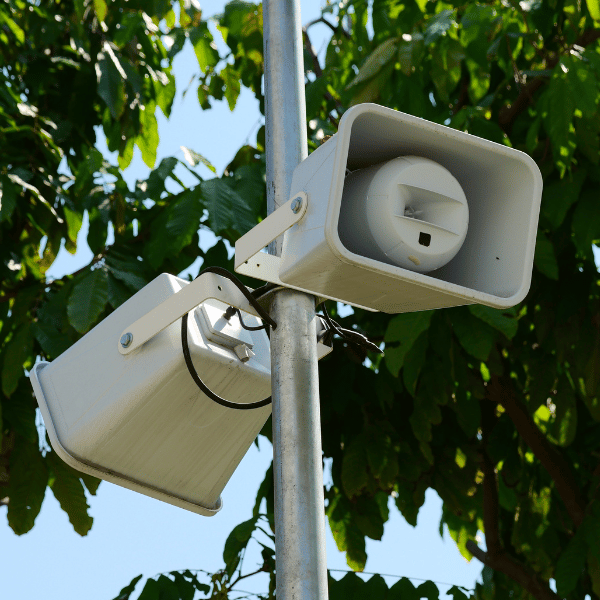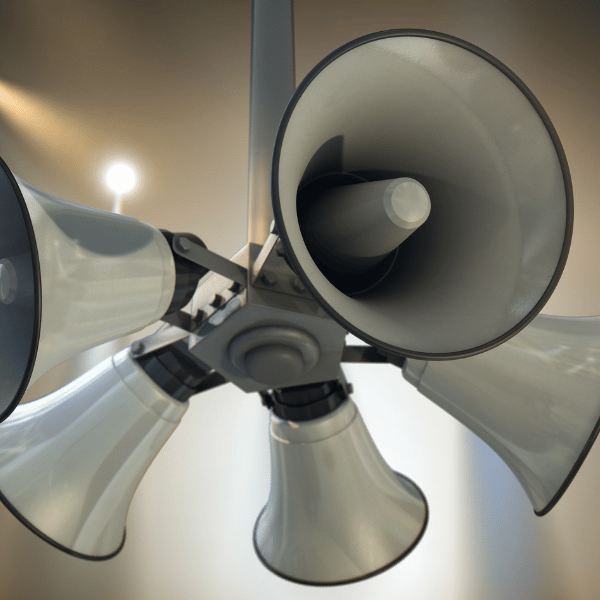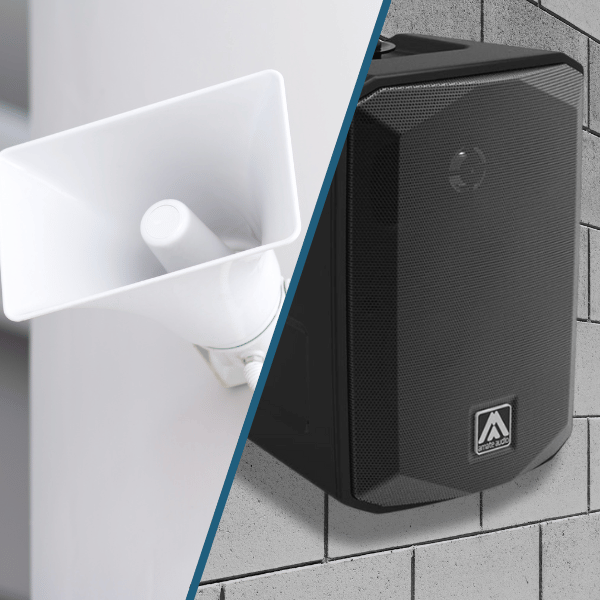Horn loudspeakers, a pivotal element in the realm of audio installations, stand out for their unique design and functionality, distinguishing themselves from conventional loudspeaker systems. The essence of horn speakers lies in their ability to project sound over long distances with remarkable clarity and efficiency. This is achieved through an acoustic horn added to the driver, which significantly improves the speaker's overall efficiency by matching the impedance of the driver to the air. This technical advantage allows horn loudspeakers to produce louder sound from the same amount of input power compared to other types of speakers.
The significance of horn-style speakers is especially pronounced in various commercial settings where clear, audible sound distribution is crucial. These settings include large venues like stadiums and concert halls, public spaces such as airports and train stations, and even outdoor areas where environmental factors can affect sound propagation. The efficiency of horn loudspeakers in converting electrical energy into sound energy makes them a preferred choice for applications requiring high sound levels without the need for excessive amplification power. This not only ensures that announcements, music, or any audio content is heard clearly by the intended audience but also contributes to the longevity and reliability of the audio system by reducing strain on the components.
Moreover, the directional nature of horn loudspeakers allows for precise control over the sound's dispersion, ensuring that audio is directed exactly where it is needed. This characteristic is invaluable in commercial settings, where managing sound spillage and ensuring audio clarity in specific zones are critical considerations. Whether integrating into a comprehensive public address system or providing focused audio solutions for specific areas, horn speakers embody a versatile and efficient option for various commercial installations.


Understanding Horn Loudspeakers
Horn loudspeakers operate on principles that leverage mechanical acoustics to enhance sound projection and efficiency. At their core, these devices consist of a driver and an acoustic horn. The driver, typically a small diaphragm that vibrates in response to an electrical signal, is responsible for creating sound waves. However, on its own, the driver might not efficiently transfer sound into the open air due to impedance mismatch—essentially, the sound waves it produces can partially reflect back, rather than efficiently radiating outward. This is where the horn comes into play, acting as an acoustic transformer.
The horn, with its distinctive flared shape, matches the impedance of the driver to the air, facilitating a smoother transition of sound waves from the driver into the surrounding environment. This design not only significantly increases the loudspeaker's efficiency but also enhances the directivity of the sound. The shape and size of the horn are meticulously calculated to ensure optimal performance, focusing the sound waves in a specific direction and reducing the dispersion that typically occurs with conventional speakers. This allows for targeted sound projection over greater distances and minimises the loss of acoustic energy.
Components of horn loudspeakers are engineered for specific applications, with variations in horn shapes and sizes tailored to different sound frequencies and dispersion requirements. From straight exponential horns designed for wide frequency response to radial and sectoral horns optimised for precise sound directionality, the design intricacies of horn loudspeakers are a testament to their versatility and technical sophistication. This specialised design enables the speakers to achieve high sound pressure levels from relatively low-powered amplifiers, making them an efficient and reliable choice for large-scale audio applications.


Key Benefits of Horn Loudspeakers
Horn loudspeakers offer several key benefits that make them exceptionally suited for a wide range of audio applications, particularly in settings where clarity and reach are paramount. Their high efficiency and sensitivity stand out as significant advantages. Due to their design, which optimally matches the impedance of the driver with the air, horn loudspeakers can convert more of the amplifier's power into usable sound. This results in a louder output for the same amount of input power compared to traditional loudspeaker designs. Such efficiency is especially beneficial in large venues and outdoor sound systems where delivering clear sound over long distances is essential, without necessitating high-powered amplifiers that consume more energy and increase operational costs.
Directional sound control is another hallmark of horn speakers, attributed to their unique shape and configuration. The design of the horn allows for precise control over the dispersion of sound waves, enabling sound engineers to direct audio to specific areas while minimising spillage into undesired zones. This capability is invaluable in environments like transportation hubs, public squares, and sports arenas, where managing sound distribution for clarity and coverage is crucial. By focusing sound where it is needed most, horn loudspeakers ensure effective communication and enhance the listening experience for the audience.
Moreover, horn loudspeakers are capable of producing high volumes with less distortion. The efficient transmission of sound from the driver through the horn means that louder volumes can be achieved without pushing the system to its limits. As a result, the sound remains clear and free from the distortion that often accompanies high-volume playback in conventional speakers. This ability to deliver loud, undistorted sound makes horn-style loudspeakers an excellent choice for applications ranging from emergency announcements to live music performances, ensuring messages and music are heard distinctly, even in challenging acoustic environments.
Applications of Hailer Speakers in Professional Settings
Horn loudspeakers, often referred to as hailer speakers in professional settings, are indispensable in a variety of applications where their distinct advantages are put to optimal use. In public address (PA) systems and outdoor events, the clarity and reach of hailer speakers make them an obvious choice. Their ability to project sound clearly over long distances without significant loss of quality ensures that messages, announcements, or music reach the audience effectively, regardless of the ambient noise or the size of the outdoor space. This attribute is particularly beneficial during large-scale events, festivals, or rallies where clear communication is essential to the experience and safety of attendees.
In emergency and public address systems, the importance of hailer speakers cannot be overstated. Their high efficiency and ability to produce clear, loud sound with minimal distortion are critical in situations where every second counts. Emergency announcements, whether in urban centres, industrial complexes, or educational campuses, rely on the penetrative sound of horn loudspeakers to cut through background noise and deliver urgent messages effectively. This capability is crucial not only for routine announcements but also for guiding crowds during emergency evacuations, ensuring instructions are heard and followed promptly.
Moreover, in theatres and large venues, hailer speakers play a vital role in delivering a high-quality audio experience. While these settings may traditionally favour a range of speaker types for different aspects of sound production, horn loudspeakers are often utilised to ensure that speech and certain sound effects are projected with clarity and directionality. Their ability to focus sound precisely makes them ideal for use in large auditoriums or open-air theatres, where controlling sound dispersion and minimising echo or feedback is essential for maintaining the integrity of the performance and ensuring the audience remains engaged and immersed.


The Importance of IP Horn Speakers
IP horn speakers represent a significant advancement in the field of audio technology, combining the traditional advantages of horn loudspeakers with modern, weatherproof designs. These speakers are engineered to withstand the elements, making them ideally suited for outdoor installations where exposure to weather is a concern. IP (Ingress Protection) ratings indicate the level of protection against both solids and liquids, ensuring that these speakers deliver reliable performance in varying environmental conditions. This resilience makes IP horn speakers a versatile and durable choice for a wide array of applications.
The benefits of IP horn speakers extend well beyond their weatherproof capabilities. In the realm of modern communication and entertainment, these speakers play a pivotal role due to their robust design and operational efficiency. They facilitate clear and reliable audio communication in outdoor settings, including parks, sports fields, and outdoor entertainment venues, where traditional speakers might falter due to weather-related damage. This ensures that messages, announcements, and music can be delivered without interruption, enhancing the experience for attendees and participants alike.
Moreover, the integration of IP horn speakers into modern communication systems underscores their importance in ensuring public safety and information dissemination. These speakers can be deployed as part of emergency warning systems in cities, coastal areas prone to natural disasters, and industrial sites requiring robust communication channels that remain operational regardless of weather conditions. The clarity and directionality of sound provided by horn speakers, combined with their weatherproof construction, make them indispensable in scenarios where failure is not an option.
In the entertainment sector, IP horn speakers enable event organisers to extend their reach to outdoor environments without compromising sound quality or equipment longevity. Whether for concerts, outdoor cinemas, or public festivals, these speakers ensure that audiences enjoy a high-quality audio experience, undiminished by the challenges posed by outdoor settings.


How to Choose the Right Horn Speaker
Choosing the right horn speaker involves careful consideration of several factors to ensure optimal performance and integration with existing audio systems. The environment where the speaker will be used is a primary consideration. For outdoor applications, selecting horn speakers with appropriate IP ratings for weatherproofing is essential. Indoor environments might require different considerations, such as acoustic characteristics.
The purpose of the horn speaker also plays a crucial role in the selection process. Different applications may demand specific features; for instance, a speaker used for background music in a commercial setting might have different requirements compared to one used for clear announcements in an emergency system. Understanding the primary function of the speaker will guide the selection towards models with the right balance of volume and directionality.
Compatibility with existing audio equipment is another critical factor. Ensuring that the horn speaker can be seamlessly integrated into your current system requires checking its compatibility with amplifiers and other components. This includes matching the speaker's impedance and power handling capabilities with that of the amplifier to prevent potential damage and optimise sound quality.
When matching horn speakers with amplifiers and other audio equipment, it's vital to consider the speaker's sensitivity and power rating. A speaker with high sensitivity requires less power to produce a given volume, allowing for more efficient use of the amplifier's output. Additionally, ensuring that the amplifier can provide enough power without exceeding the speaker's maximum rating is essential to avoid distortion and potential damage.
Lastly, consider the future scalability of your audio system. Opting for horn speakers that can accommodate additional inputs or link to expanded audio setups can save significant time and resources as your needs evolve. By carefully evaluating these factors, you can select a horn speaker that meets your requirements and enhances your audio experience.


Portable Horn Audio Solutions
Portable horn audio solutions highlight the adaptability and convenience horn speakers offer for on-the-move usage. These systems are designed to bring the distinct advantages of horn speaker technology—durability, efficiency, and clarity—to scenarios where mobility and ease of setup are paramount.
The primary benefit of portable horn speaker systems lies in their ability to deliver clear, powerful sound in various environments without the need for extensive installation or fixed infrastructure. This makes them especially valuable for outdoor events, public gatherings, emergency response scenarios, and temporary installations where traditional audio setups would be impractical or too time-consuming to deploy. The inclusion of wireless microphone technology further enhances their utility, allowing for dynamic, real-time communication that can adapt to the changing needs of the event or situation at hand.
Durability is another critical advantage. Portable horn speakers are often designed with ruggedness in mind, equipped to handle the challenges of transport and outdoor use without compromising on performance. This resilience ensures that the system remains reliable over time, providing a sound investment for entities that require audio solutions in less predictable settings.
Moreover, the efficiency of horn speakers, capable of producing high volumes from relatively low-powered amplifiers, translates into less energy consumption and longer battery life in portable systems. This efficiency, combined with their directional sound control, allows users to target audio precisely where it's needed, minimising waste and reducing the chance of noise pollution in sensitive environments.
Portable horn audio solutions offer a flexible, durable, and efficient option for bringing high-quality sound to a variety of settings, ensuring that users can achieve effective audio communication and entertainment wherever they go.


Comparing Tannoy Loudspeakers
Tannoy loudspeakers are often used instead of full-range wall-mounted speakers. Understanding the differences between these two types is crucial for selecting the right speaker for a given application.
Horn speakers, known for their high efficiency and directivity, excel in situations requiring sound to cover long distances or to be directed towards specific areas. This makes them ideal for outdoor events, public address systems, and any application where sound clarity over distance is paramount. The unique design of horn speakers allows them to project sound more effectively and with less power than their full-range counterparts. However, this efficiency comes with a trade-off in terms of frequency response. Horn speakers often focus on mid to high frequencies, which can make them less suitable for applications requiring a rich, full-bodied sound that includes deep bass tones.
Full-range wall speakers, on the other hand, are designed to provide a more comprehensive audio experience by covering a wider spectrum of frequencies. This makes them better suited for indoor environments where the quality of music and voice needs to be maintained across low, mid, and high frequencies. Full-range speakers are often preferred in bars, restaurants, theatres, and places of worship, where the fidelity of sound and the ability to reproduce the full range of music and speech nuances are critical.
The reason horn speakers are not suitable for all applications lies in their focused application scope. Their design prioritises efficiency and directionality over a full-range sound profile. While this makes them exceptional for voice announcements and certain types of live sound applications, it limits their effectiveness in settings where immersive sound quality and low-frequency performance are crucial. Consequently, choosing between horn speakers and full-range wall speakers depends on the specific requirements of the audio environment, with each offering distinct advantages for different audio applications.
Conclusion
Horn loudspeakers, with their unique design and acoustic efficiency, stand out in the audio technology landscape for their ability to project sound over long distances and maintain clarity. Their operational principle, leveraging an acoustic horn to match the driver's impedance with the air, allows for high sound levels with minimal power input, making them a preferred choice in settings where clear, directed audio is needed, such as commercial venues, public spaces, and emergency systems.
The distinct advantages of horn speakers include their high efficiency, sensitivity, and capability for directional sound control. These attributes make them suitable for a wide range of professional settings, from PA systems and outdoor events to theatres and large venues, ensuring clear audio delivery even in challenging environments.
However, the specialised nature of horn speakers means they are not universally applicable. While excellent for voice announcements and specific music applications, their design limits full-range sound quality, making full-range wall speakers a better fit for environments requiring rich, immersive audio experiences.
Portable horn speaker systems and IP-rated designs further extend the versatility of horn loudspeakers, offering durable, efficient solutions for on-the-move and outdoor audio needs. When selecting a horn speaker, considerations like the intended environment, purpose, and compatibility with existing equipment are crucial to ensure optimal performance and integration.




